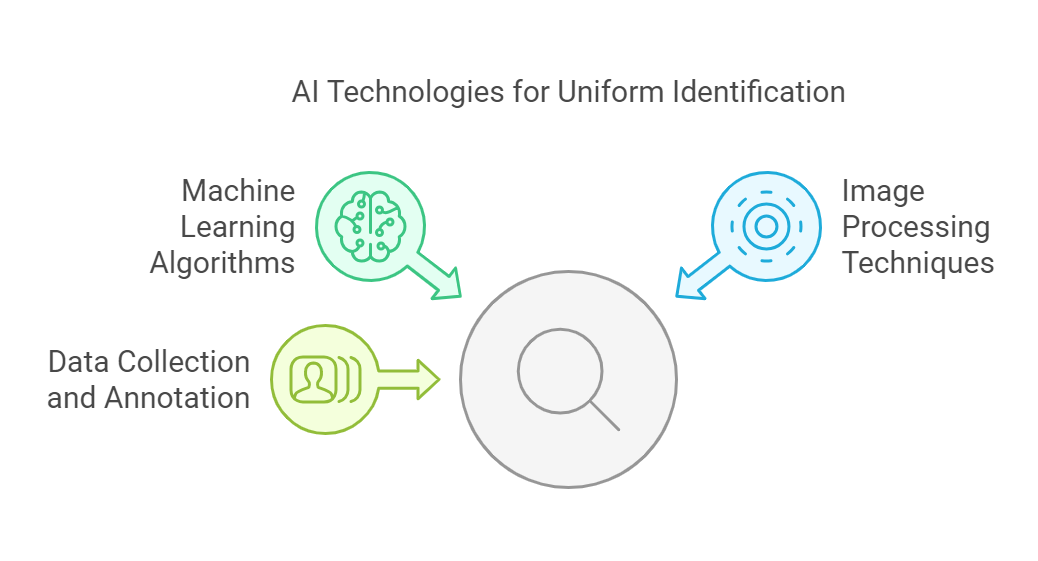Intelligent Dress Uniform Identification using Artificial Intelligence
This project explores the innovative application of artificial intelligence (AI) in the identification of dress uniforms. With the increasing complexity and variety of uniforms across different organizations, the need for an efficient and accurate identification system has become paramount. This paper outlines the methodologies, technologies, and potential impacts of implementing AI-driven solutions for uniform identification, aiming to enhance operational efficiency and security.
Introduction
The identification of dress uniforms is crucial in various sectors, including military, law enforcement, and corporate environments. Traditional methods of identification can be time-consuming and prone to human error. The integration of AI technologies offers a promising solution to streamline this process, ensuring quick and accurate recognition of uniforms.

AI Technologies in Uniform Identification
Machine Learning Algorithms
Machine learning algorithms can be trained on large datasets of uniform images to recognize patterns and features unique to each uniform type. Techniques such as convolutional neural networks (CNNs) have shown significant success in image classification tasks, making them ideal for uniform identification.
Image Processing Techniques
Advanced image processing techniques can enhance the quality of uniform images, allowing AI systems to better analyze and identify specific characteristics. Techniques such as edge detection, color analysis, and texture recognition can be employed to improve the accuracy of identification.
Data Collection and Annotation
A robust dataset is essential for training AI models effectively. Collecting a diverse range of uniform images, along with proper annotation, ensures that the AI system can learn to differentiate between various uniforms under different conditions and angles.
Implementation Strategies
Real-time Identification Systems
Implementing AI-driven identification systems in real-time scenarios, such as security checkpoints or event management, can significantly improve response times and accuracy. These systems can be integrated with surveillance cameras and mobile applications to facilitate instant identification.
Implementing AI-driven identification systems in real-time scenarios, such as security checkpoints or event management, can significantly improve response times and accuracy. These systems can be integrated with surveillance cameras and mobile applications to facilitate instant identification.
User-friendly Interfaces
Developing user-friendly interfaces for personnel to interact with the identification system is crucial. This includes mobile applications and web platforms that allow users to upload images or access identification results seamlessly.
Continuous Learning and Adaptation
AI systems should be designed to continuously learn and adapt to new uniform styles and variations. Regular updates to the training dataset and model retraining can ensure that the identification system remains effective over time.
Potential Impacts
Enhanced Security
By accurately identifying uniforms, organizations can enhance security measures, ensuring that only authorized personnel are granted access to sensitive areas or information.
Operational Efficiency
AI-driven uniform identification can streamline processes, reducing the time spent on manual identification and allowing personnel to focus on more critical tasks.
Improved Accountability
With accurate identification, organizations can improve accountability among personnel, ensuring that individuals are easily recognizable and traceable.
Conclusion
The application of artificial intelligence in dress uniform identification presents a transformative opportunity for various sectors. By leveraging machine learning, image processing, and real-time systems, organizations can enhance security, improve operational efficiency, and maintain accountability. As technology continues to evolve, the potential for AI-driven solutions in uniform identification will only grow, paving the way for smarter and more secure environments.
We have more details like Algorithm Information, Condition Checks, Technology, Industry & Human Benefits:
1. Title Page
- Title Sources
2. Abstract
- Summary of the Project
- Key Findings
- Keywords
3. Introduction
- Background
- Problem Statement
- Research Questions
- Objectives
4. Literature Review
- Theoretical Framework
- Review of Related Studies
- Gaps in the Literature
5. Project Methodology
- Research Design
- Data Collection Methods
- Data Analysis Techniques
- Ethical Considerations
6. Project Results
- Data Presentation
- Statistical Analysis
- Key Findings
7. Discussion
- Interpretation of Results
- Implications of Findings
- Limitations
8. project Conclusion
- Summary of Findings
- Recommendations
- Future Research Directions
9. References
- References and Resources Links
10. Appendices
- Final Source Code
- Survey
- Live environment/Real world Data Sets
- Additional Figures and Tables
The final table of contents depends on the project selection.


